Today was another very nice day for Free Flight models. The sun was out and the wind was light. That made flying pretty nice. There were enough thermals to catch many airplanes and get them to their "max" time, which was two minutes today, with a limited engine run. That also meant chasing was easier, since most flights were well within the 1100 acre fiend.
Here is Jim, launching his rubber powered ship:
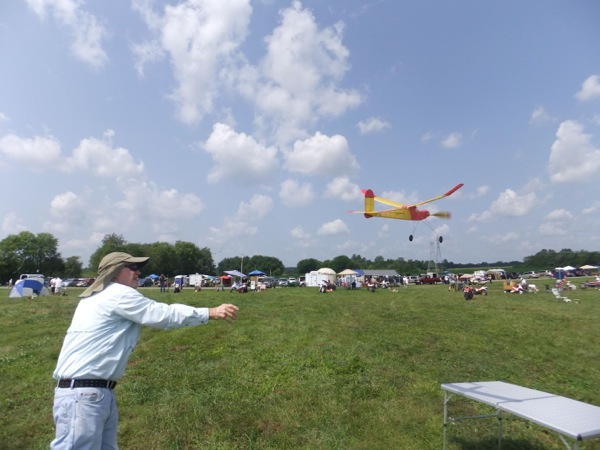
Exploring the beans
The first flight Jim Coffin made when I got there this morning, was a test flight of an old-timer style rubber powered ship. The plane flew fine, but refused to turn and motored off in a straight line over all the flyers cars and over a bean field. Unfortunately it landed right in the middle of that field as well!
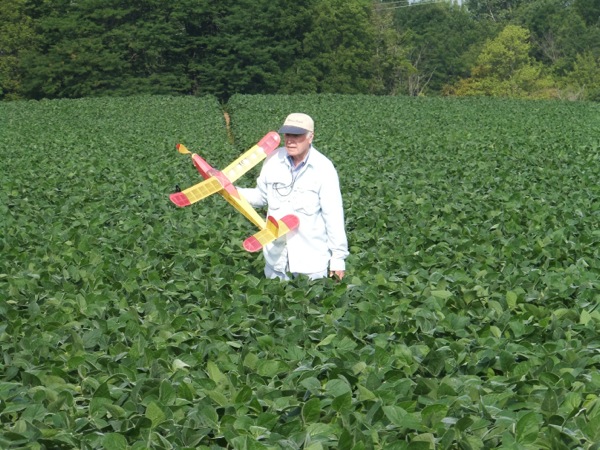
Jim got to figure out how to walk through soybeans. They were packed together with hardly any room between rows, so all he could do was shuffle through the beans trying to follow the rows and not trip. Fortunately, there was a gap in the beans that went near where he landed, so it was not too hard to get the plane. Then he had to navigate back out.
The biggest problem with all of this was the beans were wet from the morning dew. So, he got soaked from the knees down, but that made his legs cooler until things dried out.
Jim also flew his F1Q in another event. Here is a launch:
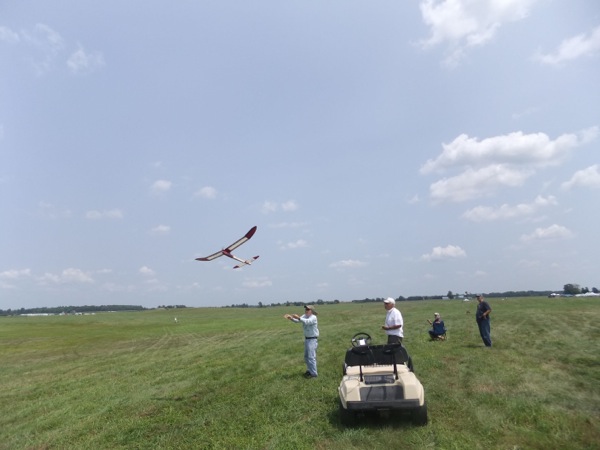
This was Jim's best flying model, and he got a max flight out of it today. Unfortunately, on other attempts, it fell out of the thermals and did not max out.
Coupe d'Hiver
This is an event I used to fly in many years ago, but it has grown up and has much more technology behind it today. These craft have carbon fibre tubes to hold the wound up rubber band, and thin aluminum tubes to support the tail section as well. The modelers use a pretty sophisticated winding scheme to make sure that a rubber band does not explode and wipe out a model as they prepare for flight.
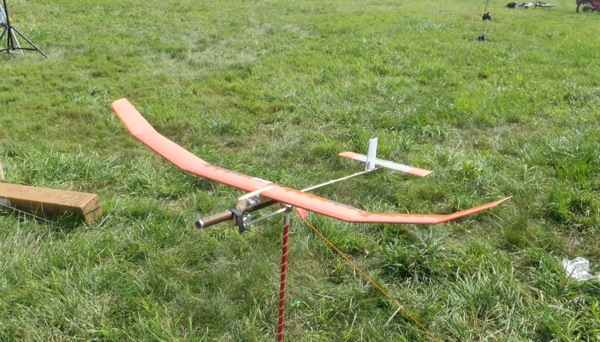
You might laugh at the idea of using a wound up rubber band to fly a serious model. If so, you probably flew a simple one as a kid, and you remember that. Rubber Power in these models is very different!
First, you use a defined weight of rubber, and the actual rubber is pretty good stuff, capable of putting a lot of power into the propeller. You loop the rubber band several times forming a bundle that is slightly longer than the distance between the propeller and a rear aluminum tube at the back of the motor tube. The trick into getting this to work so well is how you wind the rubber up.
First, you get an old fashioned hand drill and replace the drill bit with a hook. Most modelers also add a "torque meter", a device that measure how hard the rubber will spin the propeller. Then you hook this up to the front of the rubber band and pull it out of the model three or four times its normal length. Then you wind it up. By stretching the rubber out, you can pack in an incredible number of turns, far more than the old fashioned number you got as a kid. As the winds pack in, you let the rubber shorten up until you reach the limit of how many turns you can pack in. Figuring out this number may result in blowing up a model! For that reason, advanced modelers have figured out a way to wind the rubber completely removed from the model. They use an aluminum tube with a slot in it to let the rubber get in and out. This tube, with the wound up motor is slid into the motor tube on the model and hooked to a tube at the back of the model. They then slide the tube completely out of the model and hook the front part to the propeller. When the model is ready to launch, all you need to do it let go of the propeller and off it will fly!
In this particular event, it is possible that it will take almost two minutes for the rubber to unwind. What happens, though, is that there is a burst of power at the beginning of the flight which is used to get the model up high, then the torque in the rubber goes down, and the model enters a cruise mode where it might not climb, but it might now fall back down either. As the power falls off, eventually it reaches a point where it is doing more harm than good, so a device stops the propeller from spinning, and the propeller blades fold back along the nose of the model, reducing drag and the model, becomes a pure glider.
All of the pieces of the models come apart, and here is another carrier designed to hold a number of planes These boxes are made of light plywood and braced by the compartments holding the parts. Some modelers ship these boxes to events.
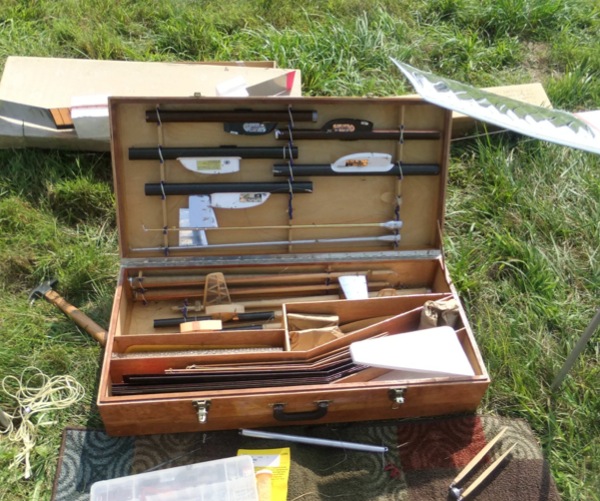
There are a variety of events for Rubber Power. Here is Dave Lacey launching his plane on a test flight:
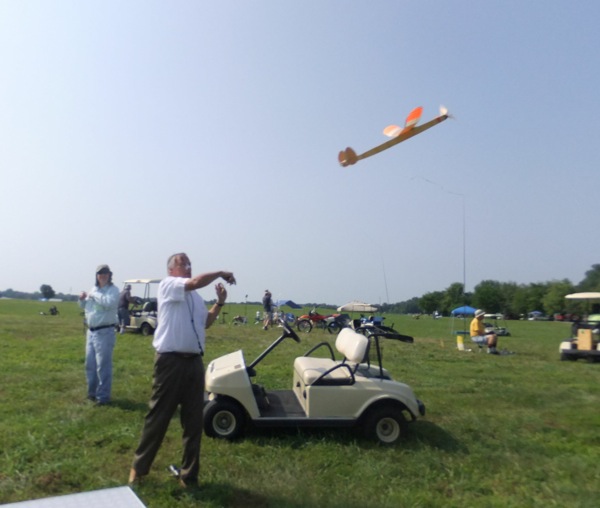
Old Timer events
There is a group of modelers who specialize in flying models whose designs and power plants date back to the 1930's. Here is one such ship. The engine on this thing looked like it had ignition (spark plug) power, but it might also be a diesel powered craft.
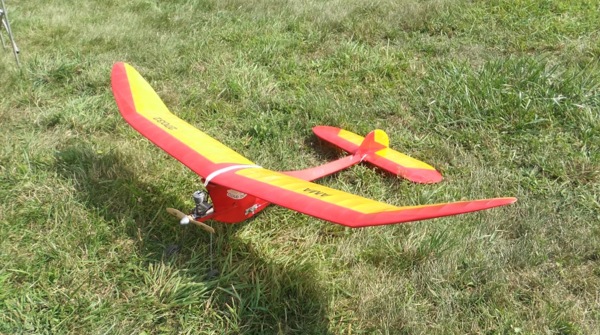
Whirling Dervishes
Perhaps the oddest event I watched today was Discus Launched Glider. These airplanes are fairly large and designed to be held by the wing tip and slung into the air after the modelers whirls around like a discus thrower, slinging the model into the air.
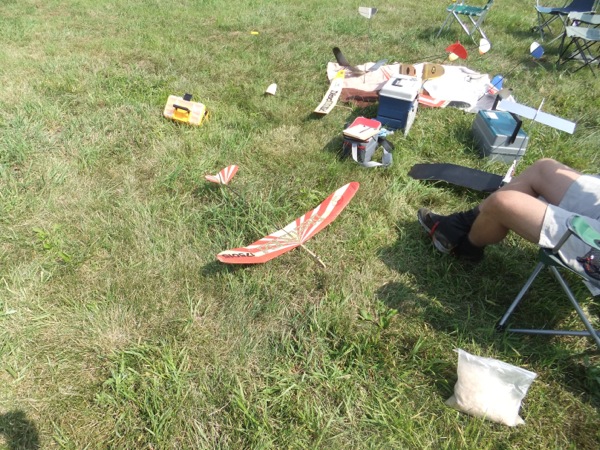
I decided that I should take movies of the modelers doing this, as one modeler had trouble keeping on his feet after the launch. It was almost as much fun watching the dance up to launch as the flight itself!
Thermal Sniffers
Since finding thermals is so important, many modelers use technology to help out. Here is a fairly hi-tech "sniffer" that holds both a temperature sensor and a wind speed indicator.
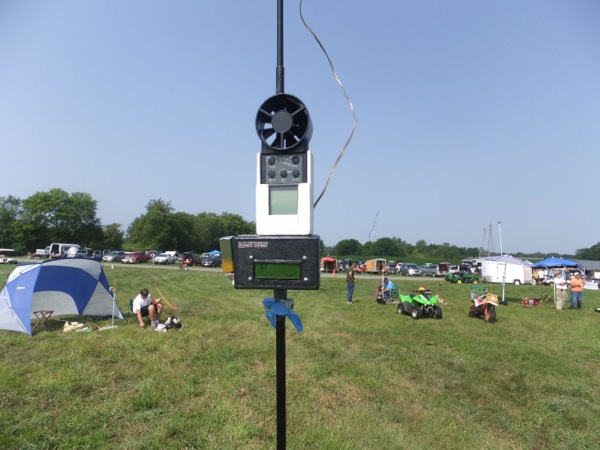
This one had graphical displays to show trends of both. When a thermal blows by, the temperature goes up and the wind dies down a bit (actually, it shifts direction in an upward direction. Most sniffer stations also sport a long fly-fishing pole with a long mylar streamer on top. You can see the thermal go by as the streamer rises up. These things are all over the place, so you can see thermals over a wide area if it helps.
Another idea for tracking thermals is to launch soap bubbles into the wind and watch them float along. Here is a bubble machine that did this. It did not seem to be too popular. Even the owner only turned it on a few times during the day.

Electric Free Flight
If I get back into this hobby, the models will all be electric powered. In my past, we used gas engines, which are hard to start (and can bite your fingers), and messy. The gas powered events are still very popular, but i like the ease of flying the electric jobs.
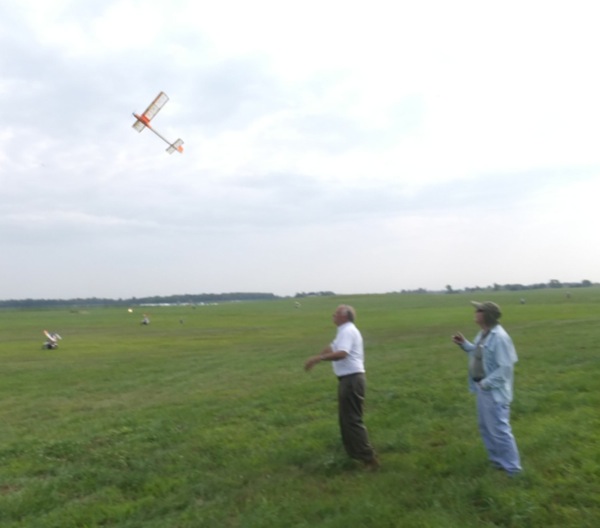
All you need to do on these things is charge the battery using a car charger, mount the battery in the model, then wander out to the launch site. There is an electronic timer (something my students could design as class projects) that controls the length of the motor run, then triggers a tiny servo mechanism to release a cable that holds down the stabilizer (the small wing at the tail). This is the "de-thermalizer" that brings the model back to earth after the maximum flight time is reached.
To launch the model, the modeler holds the model with a thumb on one button on the timer and waits for the thermal to come by. As soon as they are ready, you aim the model skyward, and pitch it into the air. As your thumb comes off the button, the motor fires up and away the model goes. Ideally, the airplane climbs skyward at a steep angle, usually turning in a tight circle as it climbs away. When the motor is shut down, the trick is to make the model slow down to gliding speed and level off smoothly, losing as little height as possible. This transition takes the model into a gliding circle. Hopefully, the model will fly into another thermal and rise up in the sky as it circles. If it falls out of the thermal, it glides back toward the ground.
If the model is still in the air when the max time is reached, the timer triggers the servo activating the de-thermalizer and the model parachutes back to earth on the wings. If the model glides into the ground before that time, well the official flight is over and the modeler's flight time is recorded.
In the old days, we used mechanical timers to control the gas engine run. The timer would pinch the gas line stopping the flow of gas to the engine bringing it to a stop. Then we used a chunk of window cord which we lit with a match. The cord would burn slowly and the length of the cord controlled how long it would take to reach a rubber band holding the tail down. When the rubber band burned through the model would de-thermalize. Not very sophisticated, but it worked!
One more day
Tomorrow is the last day of competition, then I am going back to Dayton for a few more days exploring old haunts. The model events tomorrow include rubber powered scale, which is another of my old events. Should be a nice way to wrap up this adventure!
Comments
There are no comments yet.